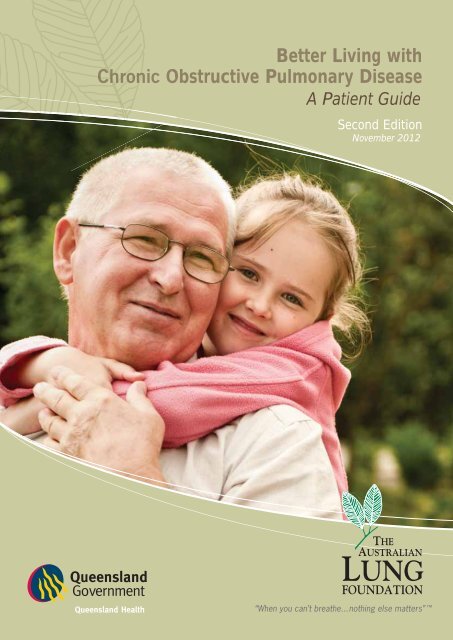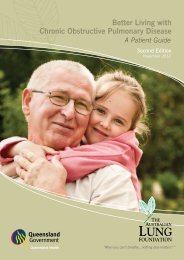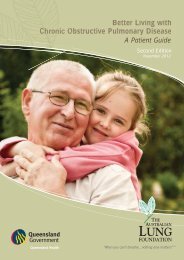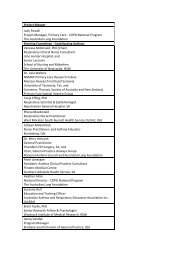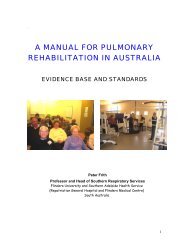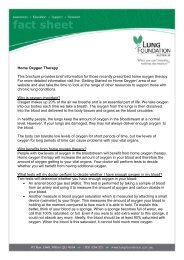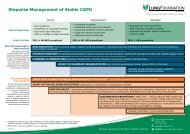COPD and swallowing - Lung Foundation
COPD and swallowing - Lung Foundation
COPD and swallowing - Lung Foundation
- No tags were found...
You also want an ePaper? Increase the reach of your titles
YUMPU automatically turns print PDFs into web optimized ePapers that Google loves.
Better Living with Chronic Obstructive Pulmonary Disease A Patient GuideBetter Living withObstructive Pulmonary DiseaseA Patient GuideSecond EditionNovember 2012Queensl<strong>and</strong> Health©The State of Queensl<strong>and</strong> (Queensl<strong>and</strong> Health) <strong>and</strong> The Australian <strong>Lung</strong> <strong>Foundation</strong> 2012a
Better Living with Chronic Obstructive Pulmonary Disease A Patient GuideBetter Living with Chronic Obstructive Pulmonary Disease A Patient Guide is a joint project of theStatewide <strong>COPD</strong> Respiratory Network, Clinical Practice Improvement Centre, Queensl<strong>and</strong> Health <strong>and</strong>The Australian <strong>Lung</strong> <strong>Foundation</strong>, <strong>COPD</strong> National Program.This work is copyright <strong>and</strong> copyright ownership is shared between the State of Queensl<strong>and</strong> (Queensl<strong>and</strong> Health)<strong>and</strong> The Australian <strong>Lung</strong> <strong>Foundation</strong> 2012. It may be reproduced in whole or in part for study, education orclinical purposes subject to the inclusion of an acknowledgement of the source. It may not be reproducedfor commercial use or sale. Reproduction for purposes other than those indicated above requires writtenpermission from both Queensl<strong>and</strong> Health <strong>and</strong> The Australian <strong>Lung</strong> <strong>Foundation</strong>.© The State of Queensl<strong>and</strong> (Queensl<strong>and</strong> Health) <strong>and</strong> The Australian <strong>Lung</strong> <strong>Foundation</strong> 2012.For further information contact Statewide Respiratory Clinical Network, Patient Safety <strong>and</strong> Quality ImprovementService, e-mail: PSQ@health.qld.gov.au or phone: (07) 36369505 <strong>and</strong> The Australian <strong>Lung</strong> <strong>Foundation</strong>,e-mail: enquiries@lungfoundation.com.au or phone: 1800 654 301. For permissions beyond the scope ofthis licence contact: Intellectual Property Offi cer, Queensl<strong>and</strong> Health, email: ip_offi cer@health.qld.gov.auor phone (07) 3234 1479.To order resources or to provide feedback please email: enquiries@lungfoundation.com.au orphone 1800 654 301.Queensl<strong>and</strong> Health Statewide Respiratory Clinical Network <strong>and</strong> The Australian <strong>Lung</strong> <strong>Foundation</strong>, <strong>COPD</strong>National Program – Better Living with Chronic Obstructive Pulmonary Disease A Patient Guide, 2012.ISBN 978-0-9872272-0-1bChapter 5: Your role in managing your chronic obstructive pulmonary disease
Better Living with Chronic Obstructive Pulmonary Disease A Patient Guidechapter16Chronic obstructive pulmonarydisease <strong>and</strong> <strong>swallowing</strong>This chapter will help you to underst<strong>and</strong>:How <strong>swallowing</strong> <strong>and</strong> breathing are related.How breathing <strong>and</strong> <strong>swallowing</strong> are affected by chronic obstructive pulmonary disease (<strong>COPD</strong>).What the consequences of <strong>swallowing</strong> problems are.How you can tell if you are experiencing <strong>swallowing</strong> problems.How a speech pathologist can help you with <strong>swallowing</strong> problems.What strategies you can use to help manage <strong>swallowing</strong> problems.How are <strong>swallowing</strong> <strong>and</strong>breathing related?Swallowing is a highly complex process involvingthe coordination of more than 26 muscles <strong>and</strong> sixnerves. For this process to occur smoothly, the bodymust also co-ordinate the breathing cycle during theswallow. Swallowing interrupts breathing. At theexact moment you swallow, you must momentarilyhold your breath to close the airway. Closing theairway prevents any food or fl uid from entering thelungs. The normal swallow–breathing cycle (shownin steps 1 to 4 in the following diagram) should onlytake a few seconds to complete.4. Return tonormalbreathing1. Before the swallow,breathe in <strong>and</strong> hold breath2. During the swallow, theairways remains closedfor about one second(to prevent food or fluidgetting into the lungs)3. After the swallow, breathe out to clearany remaining food or fluid from the throatHow are breathing <strong>and</strong> <strong>swallowing</strong>affected by <strong>COPD</strong>?How does <strong>COPD</strong> affect your breathing?Details of how <strong>COPD</strong> can affect your breathing areprovided in other sections of this Patient Guide (seechapter 12 ‘Breathlessness, breathing control <strong>and</strong>energy conservation’ on pages 52 to 57). Basically,<strong>COPD</strong> can cause you to breathe faster, which meansthat your breathing muscles can become tired <strong>and</strong>weak. Your coughing refl ex can also become weak.As breathing <strong>and</strong> <strong>swallowing</strong> are related, a weakcough refl ex can cause problems with <strong>swallowing</strong>.How does <strong>COPD</strong> affect your <strong>swallowing</strong>?Swallowing <strong>and</strong> breathing are related. Many peoplewith breathing problems also experience diffi cultyco-ordinating breathing <strong>and</strong> <strong>swallowing</strong> while eating<strong>and</strong> drinking.During mealtimes, you may use the swallow–breathing cycle more than 100 times. People whohave <strong>COPD</strong> often become short of breath duringmealtimes because of the breath-holding that occursduring the <strong>swallowing</strong>–breathing cycle. The moreshort of breath you become, the more likely youwill fi nd it diffi cult to co-ordinate your breathing<strong>and</strong> <strong>swallowing</strong>.©The State of Queensl<strong>and</strong> (Queensl<strong>and</strong> Health) <strong>and</strong> The Australian <strong>Lung</strong> <strong>Foundation</strong> 201268
Better Living with Chronic Obstructive Pulmonary Disease A Patient GuideSwallowing problems (called dysphagia) can occurbecause the need for oxygen will always overrulethe need to protect the lungs from food or fl uids.What are the consequencesof a <strong>swallowing</strong> problem?Swallowing problems <strong>and</strong> aspirationIf breathing timing is even slightly changed during<strong>swallowing</strong>, the airway may not be fully closed <strong>and</strong>food or fl uid may be breathed into the lungs. Thisis called aspiration <strong>and</strong> may lead to chest infectionsor pneumonia.Normally, when food or fl uid ‘goes down the wrongway’ (aspirated), you automatically cough up thefood or drink. As people who have <strong>COPD</strong> often havea weakened cough refl ex, they may not be able toclear all the food or fl uid out of their breathing tubesor airways.Aspiration is a symptom of <strong>swallowing</strong> problems. Theextent of the <strong>swallowing</strong> problems can change overtime, <strong>and</strong> may depend on how bad your breathingproblems are at the time (<strong>and</strong> other medical factors).As many as 20% to 40% of people who have <strong>COPD</strong>experience aspiration (particularly during a fl are up).Swallowing problems are often under-diagnosed inpeople who have <strong>COPD</strong> because silent aspirationcan be diffi cult to detect.Swallowing problems <strong>and</strong> nutritionAs you are using more energy to maintain yourbreathing during chewing <strong>and</strong> <strong>swallowing</strong>, eating<strong>and</strong> drinking can become more tiring. As a result,you may take longer to complete your meals <strong>and</strong>you may eat <strong>and</strong> drink less. Eating <strong>and</strong> drinkingless could cause you to miss out on importantnutrients <strong>and</strong> lose weight.How can you tell if you areexperiencing <strong>swallowing</strong> problems?Read the following two lists of the common signs of<strong>swallowing</strong> problems. Tick the box next to any signthat you experience when eating <strong>and</strong> drinking:List 1❑ Coughing or choking after <strong>swallowing</strong>food or drinks.❑ Increased shortness of breath during meals.❑ Wet or ‘gurgly’ voice after <strong>swallowing</strong>.❑ Feeling like food is getting stuck in the throat.❑ Diffi culty chewing foods.❑ Taking longer to start a swallow.List 2❑ Food or drink going into your nose.❑ Food or drink remaining in the mouthafter <strong>swallowing</strong>.❑ Refl ux or regurgitation.❑ Taking much longer to fi nish meals.❑ Getting more fatigued after eating <strong>and</strong> drinking.❑ Unexplained weight loss.❑ Unexplained temperatures or changes insputum colour.If you ticked two to three items (particularly those inList 1), or are concerned about your <strong>swallowing</strong>, askyour GP (or respiratory specialist) to refer you to aspeech pathologist who can assess your <strong>swallowing</strong>.69Chapter 16: Chronic obstructive pulmonary disease <strong>and</strong> <strong>swallowing</strong>
Better Living with Chronic Obstructive Pulmonary Disease A Patient GuideHow can speech pathologists helpyou with <strong>swallowing</strong> problems?Speech pathologists are trained to assess, diagnose<strong>and</strong> treat <strong>swallowing</strong> <strong>and</strong> communication problems.They can:Assess your current <strong>swallowing</strong> function <strong>and</strong>determine the cause of your <strong>swallowing</strong>problem.Recommend appropriate foods <strong>and</strong> fl uids, aswell as strategies to improve <strong>swallowing</strong> safety.Start you on <strong>swallowing</strong> therapy, if appropriate.Identify the need for further investigations.Liaise with other health care professionals.If you are experiencing <strong>swallowing</strong> problems,a speech pathologist can give you specific adviceto help you eat <strong>and</strong> drink safely.What strategies can you use to helpmanage <strong>swallowing</strong> problems?Even if you are not experiencing <strong>swallowing</strong> problems,you should be aware that there are a number ofstrategies that can be used to protect the lungs.This knowledge could help you if you do encounter<strong>swallowing</strong> problems (for example, if you have afl are up). These strategies include:Try not to eat or drink when you are breathless.Always sit upright in a supported chair whenyou are eating <strong>and</strong> drinking.Eat slowly <strong>and</strong> take small mouthfuls.Select foods that are soft <strong>and</strong> easy to chew,or add sauce or gravy to moisten foods.If worn at home, oxygen prongs should notbe removed during meals.Have smaller, more frequent meals, <strong>and</strong> takea break during your meal if you become tooshort of breath.Try to breathe out immediately after you swallowto help clear any food or fl uid left in your throat.Alternate between sips of fl uids <strong>and</strong> solids.Try <strong>swallowing</strong> twice per mouthful.Try to minimise talking during mealtimes toreduce the exertion on your breathing.Remain upright for 30 minutes after your meal.If you experience refl ux or heartburn, discussanti-refl ux medication with your GP.Managing <strong>swallowing</strong> problems dueto dry mouthPeople who have <strong>COPD</strong> often experience dry mouth.Dry mouth can be related to oxygen use (via a maskor nasal prongs), mouth breathing or medications.Having a dry mouth is uncomfortable, can increasethe risk of dental problems <strong>and</strong> can cause <strong>swallowing</strong>problems. To reduce dry mouth symptoms:Sip fl uids frequently throughout the day.Always rinse <strong>and</strong> gargle after taking yourmedication or inhalers.Use artifi cial saliva products (for example,Biotene ® or Oralube ® ), available at yourlocal pharmacy, or other oral lubricants(for example, grape seed oil fl avoured withpeppermint essence).Suck sugar free lollies or chew gum.Avoid medicated lozenges or alcohol-basedmouthwashes.Reduce your intake of caffeine, alcohol <strong>and</strong>spicy foods, <strong>and</strong> avoid smoking.Regularly brush your teeth <strong>and</strong> gums(or clean your dentures) to reduce bacteriabuild up in your mouth.Have regular dental check-ups.Talk to your GP about reviewing themedications you are taking.To overcome diffi culties with <strong>swallowing</strong>medications, try cutting or crushing yourmedications <strong>and</strong> mixing them with yoghurt,custard or jam before <strong>swallowing</strong> them.However, as not all medications can be cutor crushed, you should always check withyour GP or pharmacist fi rst.©The State of Queensl<strong>and</strong> (Queensl<strong>and</strong> Health) <strong>and</strong> The Australian <strong>Lung</strong> <strong>Foundation</strong> 201270


